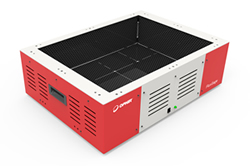MKS Instruments, Inc. has announced the Ophir® FluxGage™ 604 compact measurement system for LED luminaires. This new series features four additional color sensors evenly arranged in the bottom of the device delivering further x,y, and CCT data as well as the illuminance. Within seconds the user gets an overview of the color and overall uniformity of the measured light.
This allows direct evaluation of LED chips or optical assemblies used for color mixing and beam shaping within the design process in order to find the optics that provide the optimal light for a particular application. The system can also be used in end-of-line LED luminaire production applications to instantly detect issues, ensuring high quality product standards are met. The Ophir FluxGage measurement system also measures total luminous flux, color parameters and flicker.

"Knowing the uniformity of light is important in a wide variety of applications, such as lighting in industrial, educational, or medical facilities; offices; TV studios; as well as streets, parks, and other urban spaces," said Dr. Simon Rankel, Business Development Manager LED for the Ophir brand. "Historically, it has been challenging to measure the color uniformity of LED luminaires as measurement devices like goniometers deliver a detailed analysis but are large, relatively slow, and expensive. Ophir FluxGage 604 measurement system revolutionizes the testing of LED luminaires as the compact system only needs a space the size of the luminaire being tested, which makes handling easy. In addition, measurements can be performed in less than two seconds and literally in any environment."
Ophir FluxGage 604 measurement system features smart tristimulus (RGB) color sensors that boost the measurement system's capabilities, making it ideal for fast testing, both in R&D and for quality control in a production environment. All photometric measurements are performed in 2π (two pi) geometry, thus the color distribution of LED assemblies and luminaries can easily be evaluated with the FluxGage system. In addition, the new color-sensor functionality enables useful comparisons of the color-mixing performance of LED lenses, reflectors, diffusers, and homogenizers without the need for an expensive goniometer.
As the total luminous flux of the different LED luminaires can vary significantly depending on its application, Ophir FluxGage 604 measurement system is available in two sensitivities to deliver precise measurements. The standard FluxGage 604 measurement system measures LED luminaires in a luminous flux range between 500 and 40,000 lumens. The high-sensitivity FluxGage 604/100LM measurement system covers the range between 100 and 5,000 lumens. Both versions include four sensors to measure color uniformity.
All FluxGage systems are based on a unique technology that uses solar panels as light detectors. The panels are arranged on the inside walls of the measurement cavity and are covered with a special black layer with hundreds of transparent pinholes, creating the effect of many tiny radiometers. This design significantly reduces the reflectance of the solar panels, creating a measurement system resembling a goniophotometer in a dark room. Unlike an integrating sphere, the FluxGage system is insensitive to reflections going back and forth between the measurement device and the luminaire under test. Luminous flux and other color parameters are calculated based on the measurements of the integrated spectrometer; a fast photodiode is used for measuring flicker.
Integrated application software simplifies set up and operation; all of the photometric data of the light source is displayed. The FluxGage system connects to a PC via a USB cable. The Ophir FGC100, a NIST-traceable, broadband LED calibration standard, is used for periodic calibration of the FluxGage system.
Availability
The Ophir FluxGage 604 compact measurement system for LED luminaries is available now.